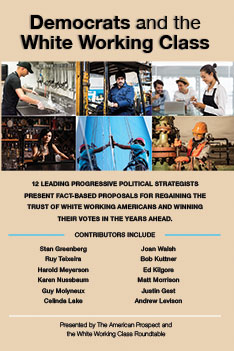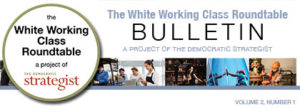




The five of us are among the founding members of the White Working Class Roundtable, a group which brings together political strategists and thinkers who seek to bridge the gap between progressives and the white working class. Early this Spring we five decided to join together to issue an invitation to a range of
prominent individuals who have devoted their careers to studying white working class Americans and ask them to present their thoughts and recommendations for the future.
The twelve papers presented in this Roundtable discussion include data derived from a wide range of research methods—from opinion polls and focus groups to sociological field studies and data gathered from door to door political canvassing and grass-roots organizing. They propose a wide variety of specific strategies and approaches but they also agree on several basic ideas.
First, progressives and Democrats should focus on the “persuadable” sector of the white working class. Data from every research method and technique indicates that there are substantial numbers of white working class Trump voters who do not genuinely share Trump’s bigotry and intolerance and who will become increasingly disillusioned as he betrays more and more of his populist campaign promises. The challenge for Democratic candidates will not be to change the minds of the substantial group of racists and bigots who are indeed among Trump’s most committed supporters but rather to present a progressive alternative that the more tolerant men and women in white working class America can find genuinely convincing and believable.
Second, progressive candidates must not only offer populist economic proposals but also a firm commitment to profoundly reforming both government at every level and also the Democratic Party itself. White working Americans are not simply cynical about the role of big money in politics. They have also become convinced that government policies and programs invariably end up benefiting either the wealthy or the poor but never themselves. They also believe that Democrats have absolutely no commitment to serious reform of this corrupt system. Many white working Americans who might otherwise be “persuadable” will simply refuse to vote for Democrats until this perception is changed.
Third, progressives and Democrats must offer white working class Americans candidates who are committed to genuinely representing them and not simply to promising them a preselected platform of
liberal programs and policies. The persuadable sector of the white working class does not need to be offered appeals to racism or other right-wing views but they must absolutely feel that a Democratic
candidate seeking their vote will be their firm and passionate advocate—someone who will be deeply committed to understanding their real day-to-day problems and representing their unique and specific needs and interests in the political system. Donald Trump’s most potent appeal to white working class voters was his charge that all of the other candidates did not even make a pretense of sincerely wanting to represent white workers while he, on the other hand, promised to be totally and exclusively “their man” and sincerely “on their side.”
Fourth, progressives and Democrats must develop local, community-based political organizations in white working class America that are built from the bottom up not the top down. Massive advertising campaigns will not win back the support of white working class Americans, no matter how cleverly written or precisely targeted such ads may be. Door to door canvassing that only occurs during election seasons will not build solid and permanent support, no matter how energetic or committed the volunteers may be. The most influential political organizer is always the person who lives on the block or the neighbor next door. Trump appeared to have no formal political organization but in reality his candidacy was supported by the vast network of permanent grass roots conservative organizations that have deep neighborhood-level roots in white working class communities—the Tea Party, The NRA, pro-life groups and other organizations of the religious right.
Finally, progressive campaigns and candidates must be committed to learning from experience. Many different progressive and Democratic groups will be running candidates and engaging in extensive voter
mobilization in 2018 and 2020. They will follow a range of strategies and offer a range of different kinds of appeals in white working class communities. Progressives and Democrats must be firmly dedicated to studying every one of these campaigns honestly and objectively, learning the lessons from their various successes and failures.
These recommendations do not offer a prescription for a quick reversal of the massive loss of white working class support progressives and Democrats suffered last year. But the simple fact is that no such quick solution is possible. We believe that progressives and Democrats can indeed regain the trust and win back the votes of the many white working Americans who have increasingly abandoned the Democratic Party but only through a hard and dedicated work that lasts for years. The reality must be faced. There is no other way.


